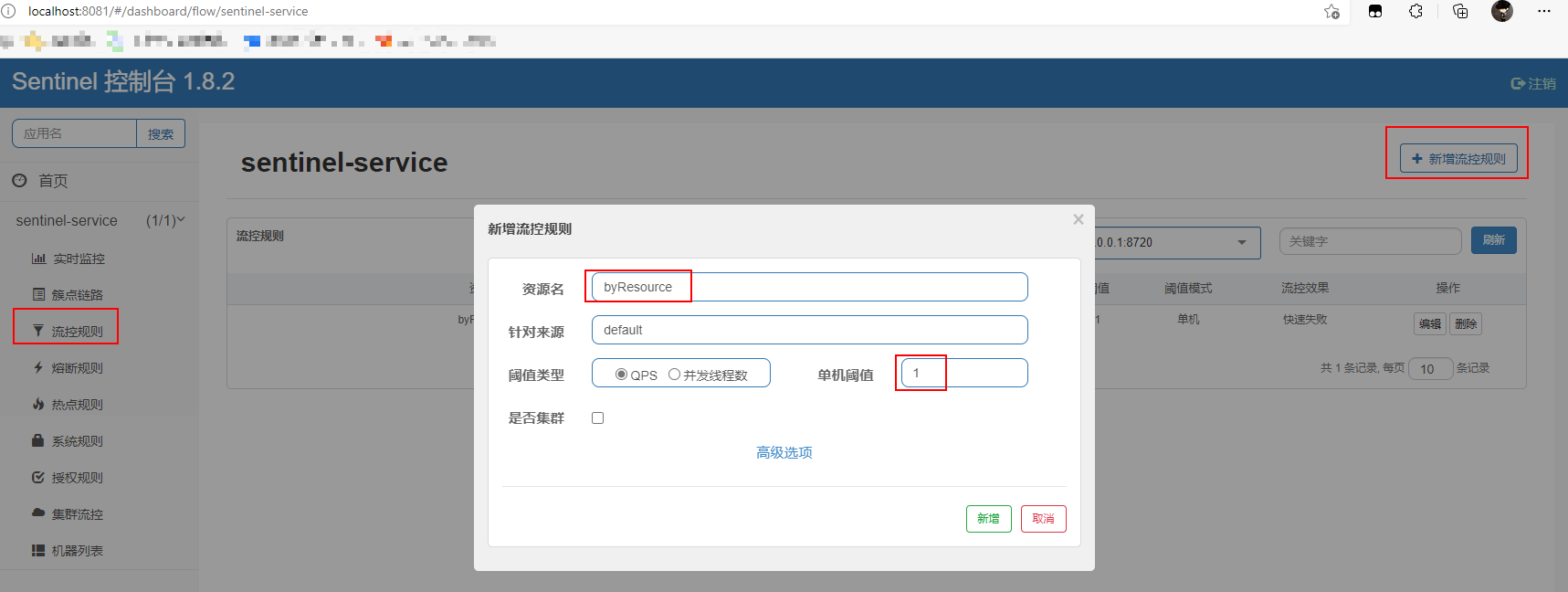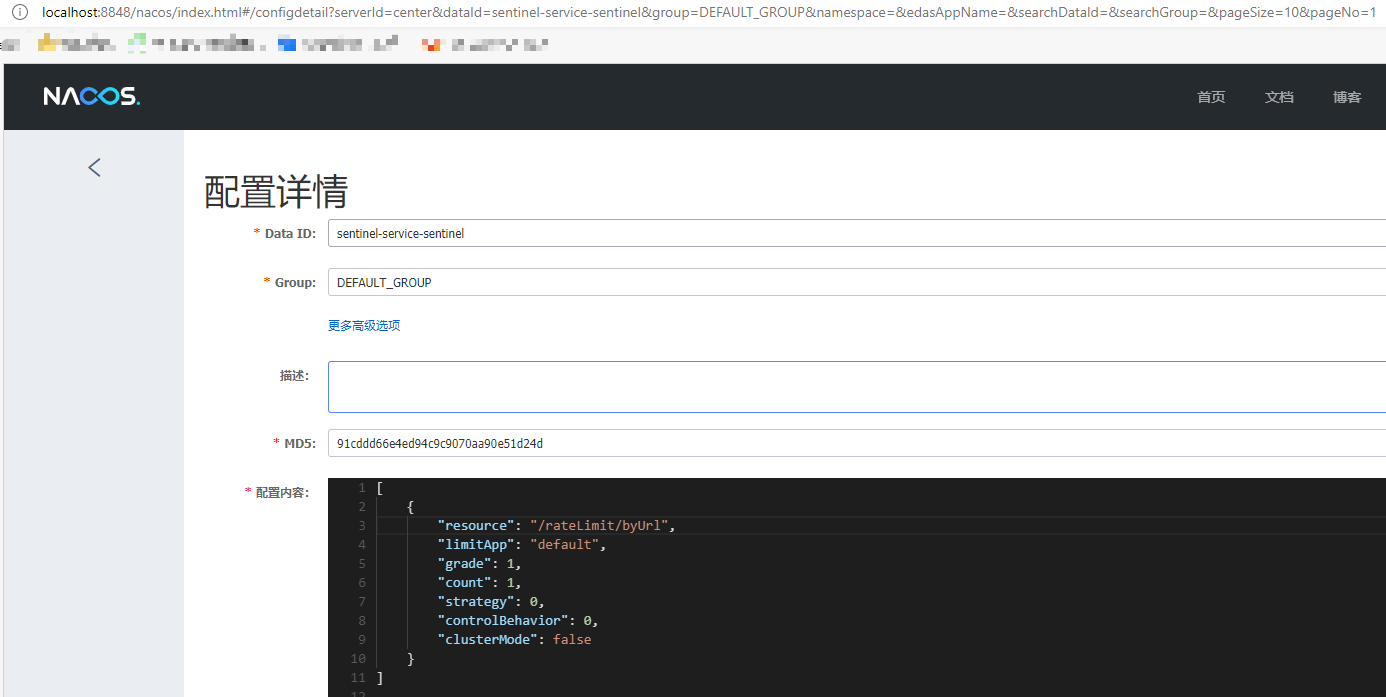Spring Cloud Alibaba 致力于提供微服务开发的一站式解决方案,Sentinel 作为其核心组件之一,具有熔断与限流等一系列服务保护功能。
# Sentinel
随着微服务的流行,服务和服务之间的稳定性变得越来越重要。 Sentinel 以流量为切入点,从流量控制、熔断降级、系统负载保护等多个维度保护服务的稳定性。
Sentinel具有如下特性:
- 丰富的应用场景:承接了阿里巴巴近 10 年的双十一大促流量的核心场景,例如秒杀,可以实时熔断下游不可用应用;
- 完备的实时监控:同时提供实时的监控功能。可以在控制台中看到接入应用的单台机器秒级数据,甚至 500 台以下规模的集群的汇总运行情况;
- 广泛的开源生态:提供开箱即用的与其它开源框架/库的整合模块,例如与 Spring Cloud、Dubbo、gRPC 的整合;
- 完善的 SPI 扩展点:提供简单易用、完善的 SPI 扩展点。您可以通过实现扩展点,快速的定制逻辑。
# 降级、熔断、限流
系统访问量突然增加,比如秒杀活动;或者某个服务崩溃了,导致调用这个服务的接口迟迟没有响应,超时;这些体验给用户都是一直等待、超时肯定是不行的,一般都会有 降级、熔断、限流 三种方式,目的就是为了快速返回,避免因为各种原因让用户无线等待。
- 降级:服务压力增加,对一些非核心业务进行降级,比如双十一,退款系统降级,优先保证下单系统
- 熔断:微服务,A调B,B调C等常链路,中途B崩溃了,需要直接熔断,快速给用户失败的返回,而不是无限堆积请求,等待,造成雪崩
- 限流:限制单位时间内请求数量,超过的限制的请求直接快速返回失败的请求
# 安装并启动
Sentinel控制台是一个轻量级的控制台应用,它可用于实时查看单机资源监控及集群资源汇总,并提供了一系列的规则管理功能,如流控规则、降级规则、热点规则等
启动:
java -jar sentinel-dashboard-1.8.2.jar
访问:http://localhost:8080,可以修改为其他端口启动--server.port=8081,默认账户密码是sentinel
# 创建sentinel-service模块
用于演示Sentinel的熔断与限流功能
pom.xml:使用nacos作为注册中心,添加nacos依赖,
<dependency>
<groupId>com.alibaba.cloud</groupId>
<artifactId>spring-cloud-starter-alibaba-nacos-discovery</artifactId>
</dependency>
<dependency>
<groupId>com.alibaba.cloud</groupId>
<artifactId>spring-cloud-starter-alibaba-sentinel</artifactId>
</dependency>
2
3
4
5
6
7
8
application.yaml:主要配置 nacos 和 sentinel 控制台地址
server:
port: 8401
spring:
application:
name: sentinel-service
cloud:
nacos:
discovery:
server-addr: localhost:8848 #配置Nacos地址
sentinel:
transport:
dashboard: localhost:8080 #配置sentinel dashboard地址
port: 8719
service-url:
user-service: http://nacos-user-service
management:
endpoints:
web:
exposure:
include: '*'
2
3
4
5
6
7
8
9
10
11
12
13
14
15
16
17
18
19
20
# 限流
Sentinel Starter 默认为所有的 HTTP 服务提供了限流埋点,我们也可以通过使用@SentinelResource来自定义一些限流行为
::: 创建 RateLimitController 类
@RestController
@RequestMapping("/rateLimit")
public class RateLimitController {
/**
* 按资源名称限流,需要指定限流处理逻辑
*/
@GetMapping("/byResource")
@SentinelResource(value = "byResource",blockHandler = "handleException")
public CommonResult byResource() {
return new CommonResult("按资源名称限流", 200);
}
/**
* 按URL限流,有默认的限流处理逻辑
*/
@GetMapping("/byUrl")
@SentinelResource(value = "byUrl",blockHandler = "handleException")
public CommonResult byUrl() {
return new CommonResult("按url限流", 200);
}
public CommonResult handleException(BlockException exception){
return new CommonResult(exception.getClass().getCanonicalName(),200);
}
}
2
3
4
5
6
7
8
9
10
11
12
13
14
15
16
17
18
19
20
21
22
23
24
25
:::
# 根据资源限流
我们可以根据@SentinelResource注解中定义的value(资源名称)来进行限流操作,但是需要指定限流处理逻辑。
启动 Nacos 和 sentinel-service 模块
由于Sentinel采用的懒加载规则,需要我们先访问下接口,Sentinel控制台中才会有对应服务信息,我们先访问下该接口:http://localhost:8401/rateLimit/byResource
- 在Sentinel控制台配置流控规则,根据
@SentinelResource注解的value值:

- 验证:快速访问
http://localhost:8401/rateLimit/byResource
// 成功返回
{
"data": null,
"message": "按资源名称限流",
"code": 200
}
// 限流返回
{
"data": null,
"message": "com.alibaba.csp.sentinel.slots.block.flow.FlowException",
"code": 200
}
2
3
4
5
6
7
8
9
10
11
12
13
# 根据Url限流
除了上面的根据@SentinelResource主机的 value 值,我们还可以通过访问的URL来限流,会返回默认的限流处理信息
相比上面的根据资源限流,只需要把资源名改为对应的 url 即可,这里是 /rateLimit/byUrl

- 验证:快速访问
http://localhost:8401/rateLimit/byUrl
// 成功访问
{
"data": null,
"message": "按url限流",
"code": 200
}
// 限流
Blocked by Sentinel (flow limiting)
2
3
4
5
6
7
8
9
# 自定义限流
除了默认的 资源限流、url限流 两种方式,我们还可以根据自己的实际情况设置限流规则
- 创建
CustomBlockHandler类用于自定义限流处理逻辑,注意方法要是static
public class CustomBlockHandler {
public static CommonResult handleException(BlockException exception){
return new CommonResult("自定义限流信息",200);
}
}
2
3
4
5
6
- 在
RateLimitController中使用自定义限流处理逻辑:
@SentinelResource注解中添加 blockHandlerClass=自己创建自定义Handler类
@RestController
@RequestMapping("/rateLimit")
public class RateLimitController {
@GetMapping("/customBlockHandler")
@SentinelResource(value = "customBlockHandler", blockHandler = "handleException", blockHandlerClass = CustomBlockHandler.class)
public CommonResult blockHandler() {
return new CommonResult("限流成功", 200);
}
}
2
3
4
5
6
7
8
9
10
- 验证:快速访问
http://localhost:8401/rateLimit/customBlockHandler
// 成功返回
{
"data": null,
"message": "限流成功",
"code": 200
}
// 自定义限流返回
{
"data": null,
"message": "自定义限流信息",
"code": 200
}
2
3
4
5
6
7
8
9
10
11
12
13
# 熔断
Sentinel 支持对服务间调用进行保护,对故障应用进行熔断操作,这里我们使用RestTemplate来调用nacos-user-service服务所提供的接口来演示下该功能,对于使用RestTemplate调用的服务,如果发生故障,回直接熔断,快速返回失败
# @SentinelRestTemplate注解
- 使用
@SentinelRestTemplate来包装下RestTemplate实例:
@Configuration
public class RibbonConfig {
@Bean
@SentinelRestTemplate
public RestTemplate restTemplate(){
return new RestTemplate();
}
}
2
3
4
5
6
7
8
9
- 添加
CircleBreakerController类,定义对nacos-user-service提供接口的调用:
定义对 nacos-user-service 接口的调用
@RestController
@RequestMapping("/breaker")
public class CircleBreakerController {
private Logger LOGGER = LoggerFactory.getLogger(CircleBreakerController.class);
@Autowired
private RestTemplate restTemplate;
@Value("${service-url.user-service}")
private String userServiceUrl;
@RequestMapping("/fallback/{id}")
@SentinelResource(value = "fallback",fallback = "handleFallback")
public CommonResult fallback(@PathVariable Long id) {
return restTemplate.getForObject(userServiceUrl + "/user/{1}", CommonResult.class, id);
}
@RequestMapping("/fallbackException/{id}")
@SentinelResource(value = "fallbackException",fallback = "handleFallback2", exceptionsToIgnore = {NullPointerException.class})
public CommonResult fallbackException(@PathVariable Long id) {
if (id == 1) {
throw new IndexOutOfBoundsException();
} else if (id == 2) {
throw new NullPointerException();
}
return restTemplate.getForObject(userServiceUrl + "/user/{1}", CommonResult.class, id);
}
public CommonResult handleFallback(Long id) {
User defaultUser = new User(-1L, "defaultUser", "123456");
return new CommonResult<>(defaultUser,"服务降级返回",200);
}
public CommonResult handleFallback2(@PathVariable Long id, Throwable e) {
LOGGER.error("handleFallback2 id:{},throwable class:{}", id, e.getClass());
User defaultUser = new User(-2L, "defaultUser2", "123456");
return new CommonResult<>(defaultUser,"服务降级返回",200);
}
}
2
3
4
5
6
7
8
9
10
11
12
13
14
15
16
17
18
19
20
21
22
23
24
25
26
27
28
29
30
31
32
33
34
35
36
37
38
- 验证:
访问 http://localhost:8401/breaker/fallback/1 成功返回,访问编号4,不存在,或者断开 nacos-user-service,返回失败信息
{
"data": {
"id": -1,
"username": "defaultUser",
"password": "123456"
},
"message": "服务降级返回",
"code": 200
}
2
3
4
5
6
7
8
9
访问 http://localhost:8401/breaker/fallbackException/2,代码中抛出一个 NullPointerException 异常,所以不会发生降级处理,其他的访问 1 或者 不存在的服务则会发生对应的异常,因为 exceptionsToIgnore参数中排除了该异常
{
"data": {
"id": -2,
"username": "defaultUser",
"password": "123456"
},
"message": "服务降级返回",
"code": 200
}
// 空指针不发生熔断降级
{
"timestamp": "2021-09-09T05:42:14.105+0000",
"status": 500,
"error": "Internal Server Error",
"message": "No message available",
"path": "/breaker/fallbackException/2"
}
2
3
4
5
6
7
8
9
10
11
12
13
14
15
16
17
18
# @SentinelRestTemplate全局代理
前面可以发现,对于每个不通类型的请求,映射的每个 RequestMapping 请求方法都需要 @SentinelResource(),如果有自定义注解,势必会写更多的方法。其实 @SentinelRestTemplate注解也支持统一的降级熔断处理,
@Configuration
public class RibbonConfig {
@Bean
// 负载均衡
@LoadBalanced
// @SentinelRestTemplate 注解的限流(blockHandler, blockHandlerClass)和降级(fallback, fallbackClass)属性不强制填写
// 给所有调用 restTemplate 的方法都添加 限流、降级,原理是给 restTemplate 添加了自定义拦截器
// CustomBlockHandler 公共处理 限流、降级的类,注意返回对象需要为原本方法要返回的对象(前端需要的对象)
@SentinelRestTemplate(blockHandlerClass = CustomBlockHandler.class, blockHandler = "handleBlock",
fallbackClass = CustomBlockHandler.class, fallback = "handleFallback"
)
public RestTemplate restTemplate() {
return new RestTemplate();
}
}
2
3
4
5
6
7
8
9
10
11
12
13
14
15
16
对应的自定义限流熔断方法
public class CustomBlockHandler {
//限流业务逻辑
public static SentinelClientHttpResponse handleBlock(HttpRequest request,
byte[] body, ClientHttpRequestExecution execution, BlockException ex) {
return new SentinelClientHttpResponse("自定义限流信息");
}
//异常熔断降级业务逻辑
public static SentinelClientHttpResponse handleFallback(HttpRequest request,
byte[] body, ClientHttpRequestExecution execution, BlockException ex) {
return new SentinelClientHttpResponse("自定义降级信息");
}
}
2
3
4
5
6
7
8
9
10
11
12
13
14
注意:
@LoadBalanced要添加,否则会报错java.net.UnknownHostException: nacos-user-service,详细参考网友分析 (opens new window),添加后有多个nacos-user-service服务,可以自动实现负载均衡全局的 @SentinelRestTemplate(),我这里没有生效,网上参考解决办法,待处理
SpringBoot SpringCloud SpringAlibaba 版本需要对应正确,参考版本对应 (opens new window),这个最直观
配置中添加下面配置,并把 RestTemplate 移动到Main主启动类中,参考 (opens new window)
# 开启或关闭@SentinelRestTemplate注解 resttemplate: sentinel: enabled: true1
2
3
4
# 整合Fegin
Sentinel也适配了Feign组件,我们使用Feign来进行服务间调用时,也可以使用它来进行熔断
- pom.xml
<dependency>
<groupId>org.springframework.cloud</groupId>
<artifactId>spring-cloud-starter-openfeign</artifactId>
</dependency>
2
3
4
- application.yaml
feign:
sentinel:
enabled: true #打开sentinel对feign的支持
2
3
- 主启动类添加
@EnableFeignClients启动Feign的功能 - 创建
UserService接口用于对nacos-user-service服务的调用,对应的实现类,用于对降级进行具体实现处理
定义UserService 接口
@FeignClient(value = "nacos-user-service",fallback = UserFallbackService.class)
public interface UserService {
@PostMapping("/user/create")
CommonResult create(@RequestBody User user);
@GetMapping("/user/{id}")
CommonResult<User> getUser(@PathVariable Long id);
@GetMapping("/user/getByUsername")
CommonResult<User> getByUsername(@RequestParam String username);
@PostMapping("/user/update")
CommonResult update(@RequestBody User user);
@PostMapping("/user/delete/{id}")
CommonResult delete(@PathVariable Long id);
}
2
3
4
5
6
7
8
9
10
11
12
13
14
15
16
17
UserService 实现类
@Component
public class UserFallbackService implements UserService {
@Override
public CommonResult create(User user) {
User defaultUser = new User(-1L, "defaultUser", "123456");
return new CommonResult<>(defaultUser,"服务降级返回",200);
}
@Override
public CommonResult<User> getUser(Long id) {
User defaultUser = new User(-1L, "defaultUser", "123456");
return new CommonResult<>(defaultUser,"服务降级返回",200);
}
@Override
public CommonResult<User> getByUsername(String username) {
User defaultUser = new User(-1L, "defaultUser", "123456");
return new CommonResult<>(defaultUser,"服务降级返回",200);
}
@Override
public CommonResult update(User user) {
return new CommonResult("调用失败,服务被降级",500);
}
@Override
public CommonResult delete(Long id) {
return new CommonResult("调用失败,服务被降级",500);
}
}
2
3
4
5
6
7
8
9
10
11
12
13
14
15
16
17
18
19
20
21
22
23
24
25
26
27
28
29
30
::: 添加 UserFeignController 中使用 UserService 通过 Feign 调用 nacos-user-service 服务中的接口
@RestController
@RequestMapping("/user")
public class UserFeignController {
@Autowired
private UserService userService;
@GetMapping("/{id}")
public CommonResult getUser(@PathVariable Long id) {
return userService.getUser(id);
}
@GetMapping("/getByUsername")
public CommonResult getByUsername(@RequestParam String username) {
return userService.getByUsername(username);
}
@PostMapping("/create")
public CommonResult create(@RequestBody User user) {
return userService.create(user);
}
@PostMapping("/update")
public CommonResult update(@RequestBody User user) {
return userService.update(user);
}
@PostMapping("/delete/{id}")
public CommonResult delete(@PathVariable Long id) {
return userService.delete(id);
}
}
2
3
4
5
6
7
8
9
10
11
12
13
14
15
16
17
18
19
20
21
22
23
24
25
26
27
28
29
30
31
:::
- 验证:调用
http://localhost:8401/user/4,返回降级
{
"data": {
"id": -1,
"username": "defaultUser",
"password": "123456"
},
"message": "服务降级返回",
"code": 200
}
2
3
4
5
6
7
8
9
# 使用Nacos存储规则
可能大家实验的时候,因为修改配置,或者代码,重启了sentinel-service服务,重新调用接口,发现 限流、熔断规则失效了,查看 Sentinel 控制台,发现规则消失了。
默认情况下,当我们在Sentinel控制台中配置规则时,控制台推送规则方式是通过API将规则推送至客户端并直接更新到内存中。一旦我们重启应用,规则将消失。
下面我们介绍下如何将配置规则进行持久化,以存储到Nacos为例
# 原理
- 我们再 Nacos 配置中心创建 限流、熔断规则,配置中心将规则推送到 Sentinel 客户端
- Sentinel 控制台 也从配置中心获取配置信息

# 实现
- 添加依赖
<dependency>
<groupId>com.alibaba.csp</groupId>
<artifactId>sentinel-datasource-nacos</artifactId>
</dependency>
2
3
4
application.yaml,添加Nacos数据源配置:
spring:
cloud:
sentinel:
datasource:
ds1:
nacos:
server-addr: localhost:8848
dataId: ${spring.application.name}-sentinel
groupId: DEFAULT_GROUP
data-type: json
rule-type: flow
2
3
4
5
6
7
8
9
10
11
- 在 Nacos 中添加配置

相关参数解释:
- resource:资源名称;
- limitApp:来源应用;
- grade:阈值类型,0表示线程数,1表示QPS;
- count:单机阈值;
- strategy:流控模式,0表示直接,1表示关联,2表示链路;
- controlBehavior:流控效果,0表示快速失败,1表示Warm Up,2表示排队等待;
- clusterMode:是否集群。
返回 Sentinel 控制台可以发现 已经有一条限流规则了,且访问接口验证生效,重启 sentinel-service ,查看 sentinel 控制台,限流规则仍然存在
